Abstract
Large, soluble ds (double-stranded) DNA-IgG (immunoglobulin G) anti-dsDNA immune complexes (greater than or equal to 200 S) that were previously opsonized with complement were digested with DNAase. The small complement-component-C3-fragment-labelled IgG (11-14 S) that was then isolated did not bind effectively to complement receptor type 1 on human red blood cells. However, when this IgG was immune-complexed with 3H-labelled PM2 (bacteriophage directed against a marine Pseudomonas) dsDNA (Mr approximately 6 X 10(6), substantial binding of both the DNA antigen and IgG to the erythrocytes was demonstrable.
Full text
PDF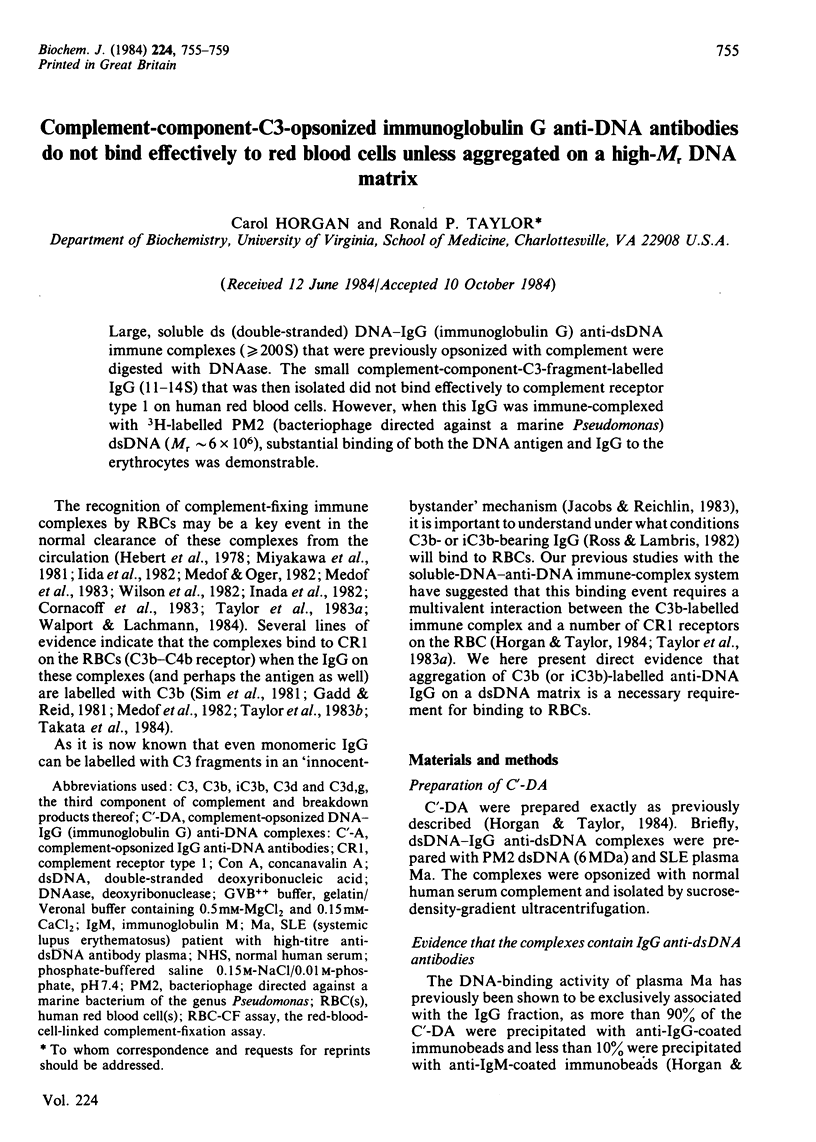
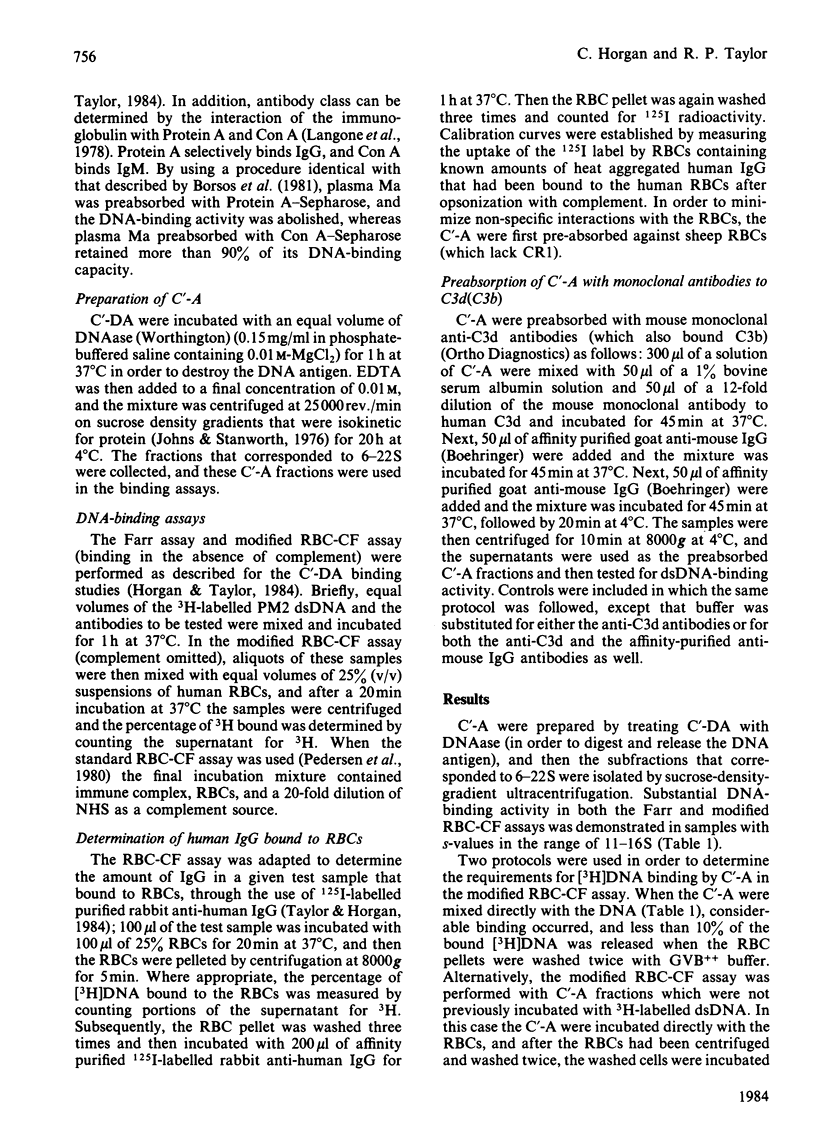
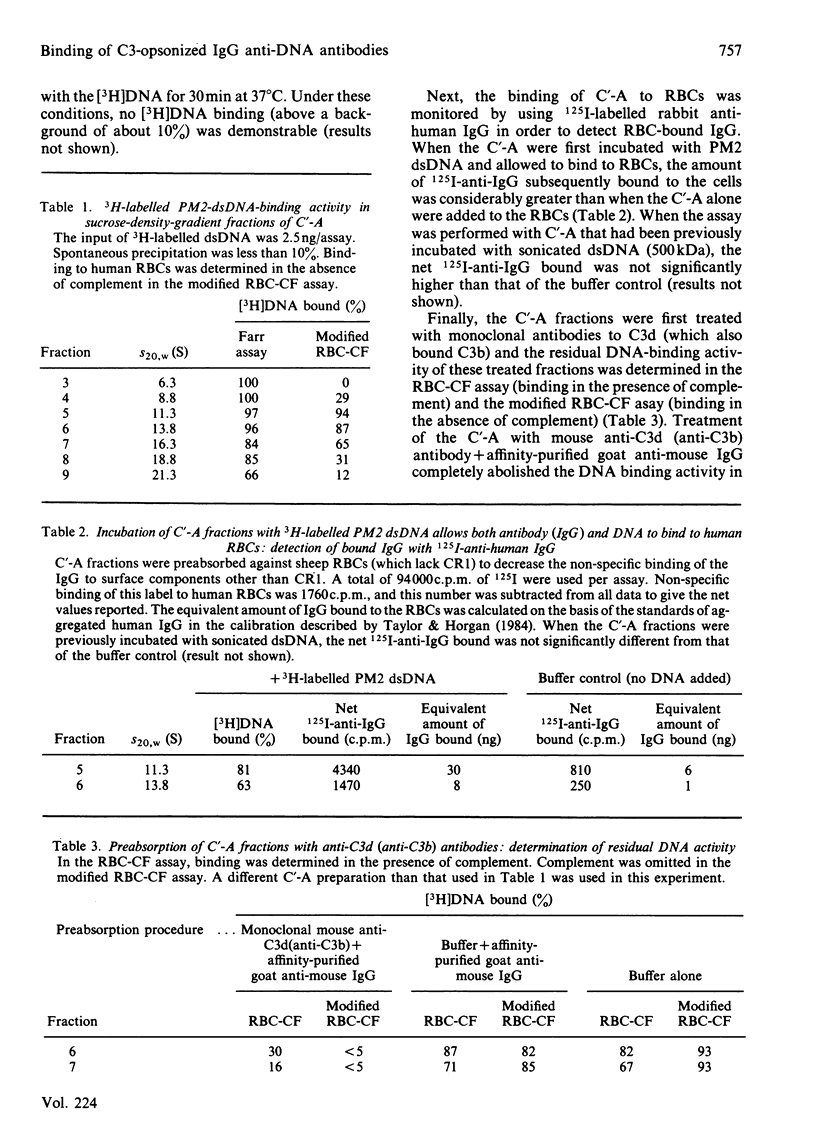
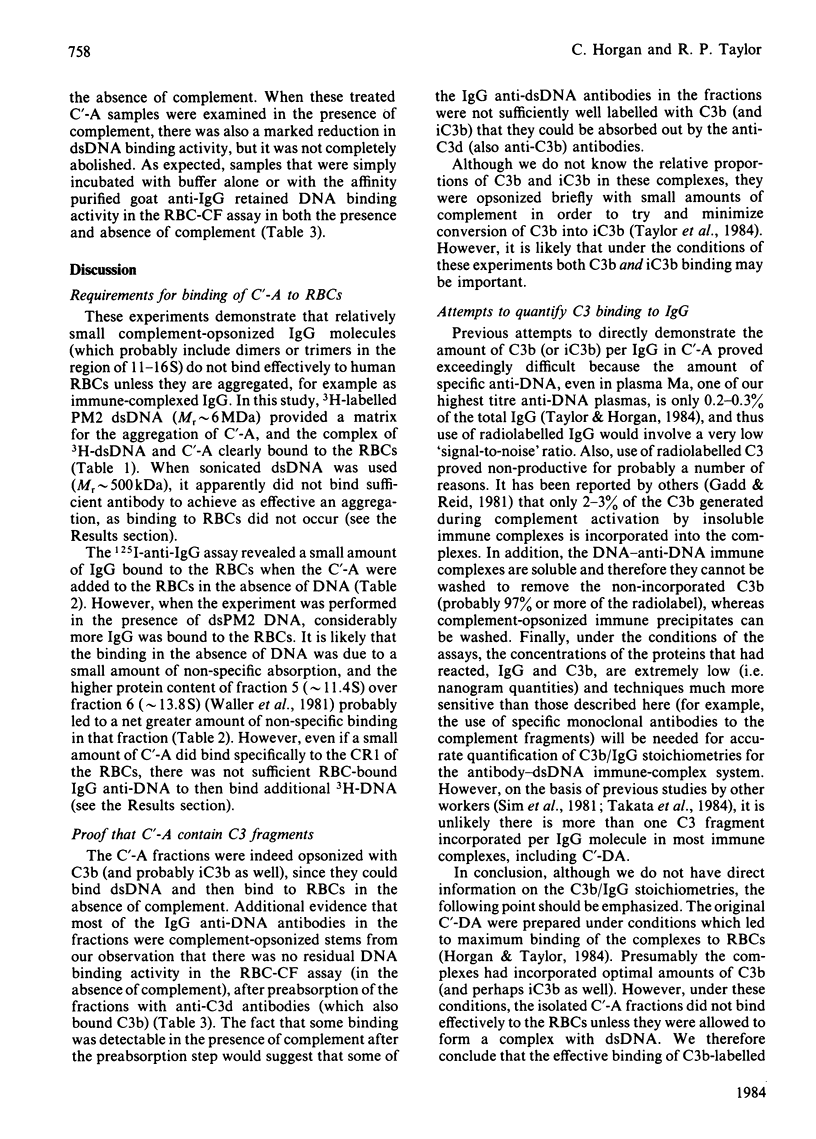
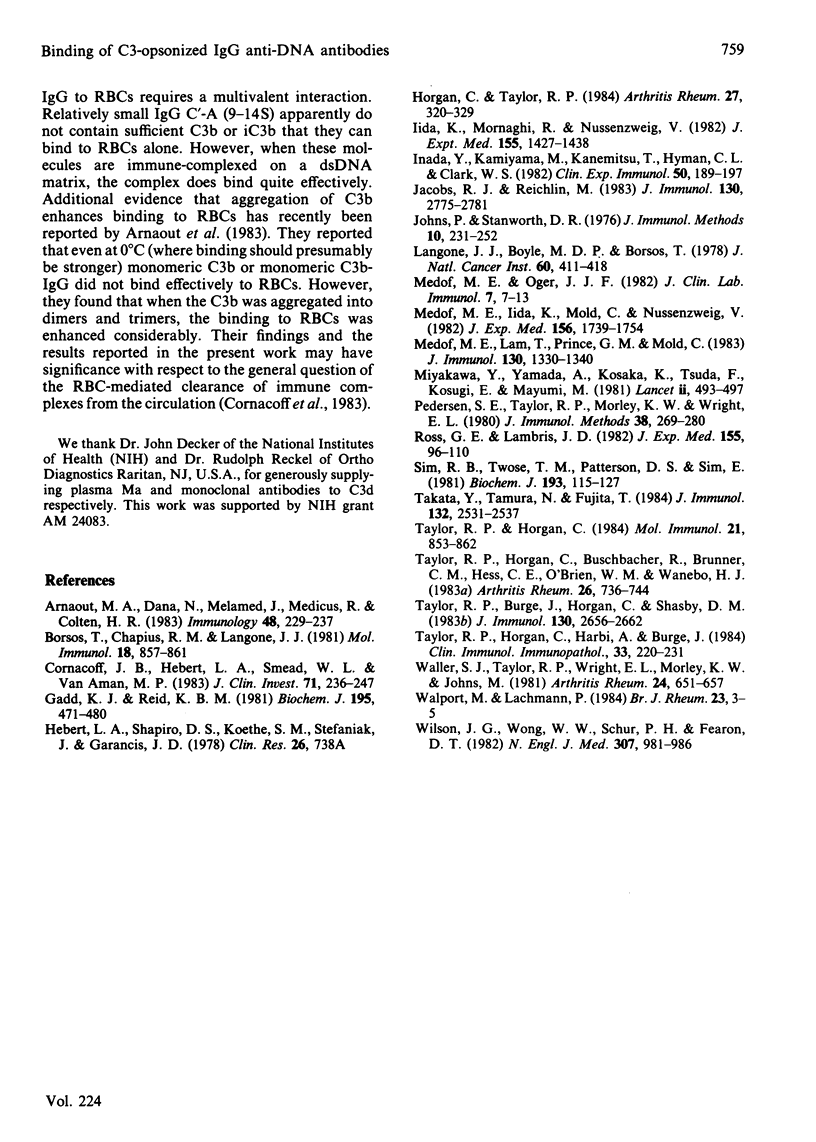
Selected References
These references are in PubMed. This may not be the complete list of references from this article.
- Arnaout M. A., Dana N., Melamed J., Medicus R., Colten H. R. Low ionic strength or chemical cross-linking of monomeric C3b increases its binding affinity to the human complement C3b receptor. Immunology. 1983 Feb;48(2):229–237. [PMC free article] [PubMed] [Google Scholar]
- Borsos T., Chapuis R. M., Langone J. J. Natural antibodies in mammalian sera to folinic acid and methotrexate. Mol Immunol. 1981 Sep;18(9):857–862. doi: 10.1016/0161-5890(81)90007-9. [DOI] [PubMed] [Google Scholar]
- Cornacoff J. B., Hebert L. A., Smead W. L., VanAman M. E., Birmingham D. J., Waxman F. J. Primate erythrocyte-immune complex-clearing mechanism. J Clin Invest. 1983 Feb;71(2):236–247. doi: 10.1172/JCI110764. [DOI] [PMC free article] [PubMed] [Google Scholar]
- Gadd K. J., Reid K. B. The binding of complement component C3 to antibody-antigen aggregates after activation of the alternative pathway in human serum. Biochem J. 1981 May 1;195(2):471–480. doi: 10.1042/bj1950471. [DOI] [PMC free article] [PubMed] [Google Scholar]
- Horgan C., Taylor R. P. Studies on the kinetics of binding of complement-fixing dsDNA/anti-dsDNA immune complexes to the red blood cells of normal individuals and patients with systemic lupus erythematosus. Arthritis Rheum. 1984 Mar;27(3):320–329. doi: 10.1002/art.1780270312. [DOI] [PubMed] [Google Scholar]
- Iida K., Mornaghi R., Nussenzweig V. Complement receptor (CR1) deficiency in erythrocytes from patients with systemic lupus erythematosus. J Exp Med. 1982 May 1;155(5):1427–1438. doi: 10.1084/jem.155.5.1427. [DOI] [PMC free article] [PubMed] [Google Scholar]
- Inada Y., Kamiyama M., Kanemitsu T., Hyman C. L., Clark W. S. Studies on immune adherence (C3b) receptor activity of human erythrocytes: relationship between receptor activity and presence of immune complexes in serum. Clin Exp Immunol. 1982 Oct;50(1):189–197. [PMC free article] [PubMed] [Google Scholar]
- Jacobs R. J., Reichlin M. Generation of low m.w., C3-bearing immunoglobulin in human serum. J Immunol. 1983 Jun;130(6):2775–2781. [PubMed] [Google Scholar]
- Johns P., Stanworth D. R. A simple numerical method for the construction of isokinetic sucrose density gradients, and their application to the characterisation of immunoglobulin complexes. J Immunol Methods. 1976 Mar;10(2-3):231–252. doi: 10.1016/0022-1759(76)90174-5. [DOI] [PubMed] [Google Scholar]
- Langone J. J., Boyle M. D., Borsos T. Complement-dependent cytotoxic antitumor antibody. I. Immunoglobulin class determined by interaction with protein A or concanavalin A. J Natl Cancer Inst. 1978 Feb;60(2):411–418. doi: 10.1093/jnci/60.2.411. [DOI] [PubMed] [Google Scholar]
- Medof M. E., Iida K., Mold C., Nussenzweig V. Unique role of the complement receptor CR1 in the degradation of C3b associated with immune complexes. J Exp Med. 1982 Dec 1;156(6):1739–1754. doi: 10.1084/jem.156.6.1739. [DOI] [PMC free article] [PubMed] [Google Scholar]
- Medof M. E., Lam T., Prince G. M., Mold C. Requirement for human red blood cells in inactivation of C3b in immune complexes and enhancement of binding to spleen cells. J Immunol. 1983 Mar;130(3):1336–1340. [PubMed] [Google Scholar]
- Medof M. E., Oger J. J. Competition for immune complexes by red cells in human blood. J Clin Lab Immunol. 1982 Jan;7(1):7–13. [PubMed] [Google Scholar]
- Miyakawa Y., Yamada A., Kosaka K., Tsuda F., Kosugi E., Mayumi M. Defective immune-adherence (C3b) receptor on erythrocytes from patients with systemic lupus erythematosus. Lancet. 1981 Sep 5;2(8245):493–497. doi: 10.1016/s0140-6736(81)90882-5. [DOI] [PubMed] [Google Scholar]
- Pedersen S. E., Taylor R. P., Morley K. W., Wright E. L. Stability of DNA/ANTI-DNA complexes. IV. Complement fixation. J Immunol Methods. 1980;38(3-4):269–280. doi: 10.1016/0022-1759(80)90275-6. [DOI] [PubMed] [Google Scholar]
- Ross G. D., Lambris J. D. Identification of a C3bi-specific membrane complement receptor that is expressed on lymphocytes, monocytes, neutrophils, and erythrocytes. J Exp Med. 1982 Jan 1;155(1):96–110. doi: 10.1084/jem.155.1.96. [DOI] [PMC free article] [PubMed] [Google Scholar]
- Sim R. B., Twose T. M., Paterson D. S., Sim E. The covalent-binding reaction of complement component C3. Biochem J. 1981 Jan 1;193(1):115–127. doi: 10.1042/bj1930115. [DOI] [PMC free article] [PubMed] [Google Scholar]
- Takata Y., Tamura N., Fujita T. Interaction of C3 with antigen-antibody complexes in the process of solubilization of immune precipitates. J Immunol. 1984 May;132(5):2531–2537. [PubMed] [Google Scholar]
- Taylor R. P., Burge J., Horgan C., Shasby D. M. The complement-mediated binding of soluble antibody/dsDNA immune complexes to human neutrophils. J Immunol. 1983 Jun;130(6):2656–2662. [PubMed] [Google Scholar]
- Taylor R. P., Horgan C., Buschbacher R., Brunner C. M., Hess C. E., O'Brien W. M., Wanebo H. J. Decreased complement mediated binding of antibody/3H-dsDNA immune complexes to the red blood cells of patients with systemic lupus erythematosus, rheumatoid arthritis, and hematologic malignancies. Arthritis Rheum. 1983 Jun;26(6):736–744. doi: 10.1002/art.1780260606. [DOI] [PubMed] [Google Scholar]
- Taylor R. P., Horgan C., Harbin A., Burge J. Suramin inhibits the binding of complement-fixing antibody/double-stranded DNA immune complexes to CR1. Clin Immunol Immunopathol. 1984 Nov;33(2):220–231. doi: 10.1016/0090-1229(84)90077-1. [DOI] [PubMed] [Google Scholar]
- Taylor R. P., Horgan C. Quantitative determination of anti-dsDNA antibodies and antibody/dsDNA stoichiometries in prepared, soluble complement-fixing antibody/dsDNA immune complexes. Mol Immunol. 1984 Oct;21(10):853–862. doi: 10.1016/0161-5890(84)90139-1. [DOI] [PubMed] [Google Scholar]
- Waller S. J., Taylor R. P., Wright E. L., Morley K. W., Johns M. DNA/anti-DNA complexes: correlation of size and complement fixation. Arthritis Rheum. 1981 May;24(5):651–657. doi: 10.1002/art.1780240504. [DOI] [PubMed] [Google Scholar]
- Walport M., Lachmann P. C3 receptors, complement deficiency and SLE. Br J Rheumatol. 1984 Feb;23(1):3–5. doi: 10.1093/rheumatology/23.1.3. [DOI] [PubMed] [Google Scholar]
- Wilson J. G., Wong W. W., Schur P. H., Fearon D. T. Mode of inheritance of decreased C3b receptors on erythrocytes of patients with systemic lupus erythematosus. N Engl J Med. 1982 Oct 14;307(16):981–986. doi: 10.1056/NEJM198210143071604. [DOI] [PubMed] [Google Scholar]


